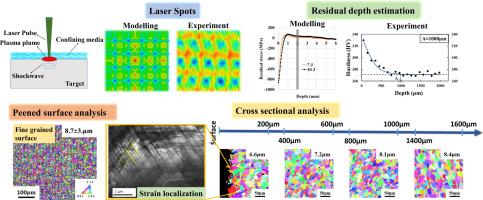高能激光冲击强化镍基超合金变形特性和腐蚀性能的定量分析
IF 5.3
2区 材料科学
Q1 MATERIALS SCIENCE, COATINGS & FILMS
引用次数: 0
摘要
本研究探讨了使用 7 J 和 10 J 脉冲能量的高能激光冲击强化(LSP)对 Inconel 718 超合金表层下变形特性的影响。在 LSP 之后,样品中产生了高强度的压缩残余应力,残余应力深度达到 2 mm 左右--实验观察结果与 LSP 过程的有限元分析结果非常吻合。强烈冲击波的传播导致应变硬化和位错密度增加,同步辐射衍射和透射电子显微镜对其进行了实验量化。显微分析表明,晶粒结构仅在表面高度细化,在残余深度区域没有观察到明显的细化。除了高度应变硬化外,在硬化深度还观察到大量绝热剪切带,表明在如此高的激光脉冲能量下应变同时定位。这些剪切带沿着 Ni γ 基质中的共同滑移面出现,可能是导致失效的潜在不稳定区域。经过 LSP 处理的样品具有更好的耐腐蚀性,激光脉冲能量更高的强化样品性能更好。本文章由计算机程序翻译,如有差异,请以英文原文为准。

Quantitative analysis of deformation characteristics and corrosion properties of high energy laser shock peened Ni-based superalloy
This study examines the influence of high-energy laser shock peening (LSP) using 7 J and 10 J pulse energies on the sub-surface deformation characteristics of Inconel 718 superalloy. High-magnitude compressive residual stresses were induced into the samples after LSP with large residual stress depths of the order of 2 mm – the experimental observations were in good agreement with finite element analyses of the LSP process. The propagation of intense shock waves led to increased strain hardening and dislocation densities that were experimentally quantified by synchrotron diffraction and transmission electron microscopy. Microscopic analyses revealed highly refined grain structure only at the surface without much refinement observed in the residual depth region. Alongside a high degree of strain hardening, profuse amount of adiabatic shear bands was observed in the hardened depth, indicative of simultaneous strain localisation under such high laser pulse energy. These bands occurred along common slip planes in the Ni γ-matrix and could be potential areas of instability leading to failure. The LSP-treated samples exhibited improved corrosion resistance, with higher laser pulse energy peened samples performing better.
求助全文
通过发布文献求助,成功后即可免费获取论文全文。
去求助
来源期刊

Surface & Coatings Technology
工程技术-材料科学:膜
CiteScore
10.00
自引率
11.10%
发文量
921
审稿时长
19 days
期刊介绍:
Surface and Coatings Technology is an international archival journal publishing scientific papers on significant developments in surface and interface engineering to modify and improve the surface properties of materials for protection in demanding contact conditions or aggressive environments, or for enhanced functional performance. Contributions range from original scientific articles concerned with fundamental and applied aspects of research or direct applications of metallic, inorganic, organic and composite coatings, to invited reviews of current technology in specific areas. Papers submitted to this journal are expected to be in line with the following aspects in processes, and properties/performance:
A. Processes: Physical and chemical vapour deposition techniques, thermal and plasma spraying, surface modification by directed energy techniques such as ion, electron and laser beams, thermo-chemical treatment, wet chemical and electrochemical processes such as plating, sol-gel coating, anodization, plasma electrolytic oxidation, etc., but excluding painting.
B. Properties/performance: friction performance, wear resistance (e.g., abrasion, erosion, fretting, etc), corrosion and oxidation resistance, thermal protection, diffusion resistance, hydrophilicity/hydrophobicity, and properties relevant to smart materials behaviour and enhanced multifunctional performance for environmental, energy and medical applications, but excluding device aspects.
 求助内容:
求助内容: 应助结果提醒方式:
应助结果提醒方式:


